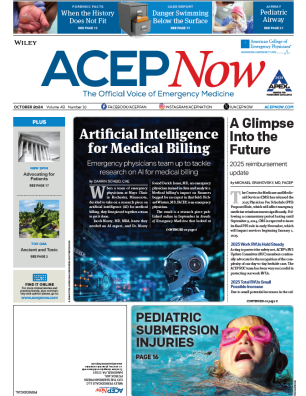When we think of emergency physician wellness, the threat of infectious disease does not immediately come to mind. Most of us are reassured that universal precautions and the recent innovations in safety needles will protect us from the usual suspects. Most of us are immunized against hepatitis B and tested yearly for the rare case of tuberculosis.
Explore This Issue
ACEP News: Vol 28 – No 05 – May 2009But what if there was an infectious disease spread by respiratory droplets, was increasing logarithmically in the community, and had a transmission rate as high as 90%? What if it took 8-10 weeks to recover from the disease, which has a 15%-30% complication rate? The average victim would lose a week of work or more.
Now consider that, if you brought it home to your kids, there would be a 25% incidence of secondary pneumonia for toddlers and a significant rate of death for infants.
We are talking about pertussis—and it’s back with a vengeance.
At its height in the 1930s-1940s, pertussis was reported in 250,000 Americans during its 3- to 5-year epidemic cycle. This was probably significantly underreported. In that preantibiotic era, it was feared as the “whooping cough,” and its mortality rate made it one of the great scourges of children.
When the pertussis vaccine came into use in the 1940s, the incidence dropped to less than 1 case per 100,000 people. Because humans are the only known reservoir of the disease, public heath officials talked about having conquered it.
As time passed, however, the immunity conferred by the vaccine proved to last only 5-10 years. Booster shots for adolescents and adults were not considered feasible on a wide scale, because the reactions to the original viral vaccine (and even to the subsequent acellular vaccine) were too common and bothersome.
By 2002, there were more than 25,000 reported cases of pertussis, and officials with the Centers for Disease Control and Prevention (CDC) believe the underreporting level was 90%-95%.
By 2006, the incident rate rose to 5.2 reported cases per 100,000 people, and probably twice that, in reality. That’s a 5- to 10-fold increase. Eight cases in 10 are in adolescents and adults—including emergency physicians. It is the only vaccine-preventable disease currently on the rise.
The real risk to emergency physicians and their families is that the first week of pertussis looks like any viral syndrome and is misdiagnosed as such. But the Bordetella pertussis bacteria are transmitted during this stage, as well as in the subsequent stages. By the time a patient comes in complaining of a month of cough, we already have what we believe is their cold.
Pages: 1 2 | Single Page


No Responses to “Caution: The Whooping Cough Is Back”